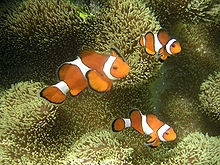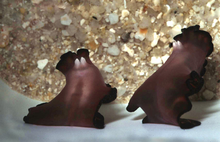 In biology, a hermaphrodite is an organism that has reproductive organs normally associated with both male and female sexes. [1] Many taxonomic groups of animals (mostly invertebrates) do not have separate sexes. [2]
In these groups, hermaphroditism is a normal condition for a sexual
form of reproduction in which both partners can act as "female" or
"male". For example, the vast majority of tunicates, pulmonate snails, opisthobranch snails and slugs are hermaphrodites. Hermaphroditism is also found in some species of fish and to a lesser degree in other vertebrates. Most plants are also hermaphrodites.
In biology, a hermaphrodite is an organism that has reproductive organs normally associated with both male and female sexes. [1] Many taxonomic groups of animals (mostly invertebrates) do not have separate sexes. [2]
In these groups, hermaphroditism is a normal condition for a sexual
form of reproduction in which both partners can act as "female" or
"male". For example, the vast majority of tunicates, pulmonate snails, opisthobranch snails and slugs are hermaphrodites. Hermaphroditism is also found in some species of fish and to a lesser degree in other vertebrates. Most plants are also hermaphrodites.A rough estimate of the number of hermaphroditic species is 65,000. [3] As the estimated total number of animal species is 1.2 million, the percentage of animals that are hermaphrodites is about 5%. Arthropods are the phylum with the greatest number of species. If these are excluded, the species in the remaining approximately 33 phyla are about a third hermaphrodite. Most hermaphroditic species show a degree of self-fertilization with fractional rates ranging from 0 to 1.0. The distribution of self-fertilization rate in animals is similar to that of plants, suggesting that similar processes function to direct the evolution of selfing in animals and plants. [3]
Historically, the term hermaphrodite has also been used to describe ambiguous genitalia and gonadal mosaicism in individuals gonochoric species, especially humans. The intersex word came into practical use for humans, since the word hermaphrodite is considered misleading and stigmatizing, [4] [5] and "specious and clinically problematic". [6]Etymology
The term derives from the Latin: Hermaphrodite, Ancient Greek: Hermaphrodite ἑρμαφρόδιτος, [7] which stems from Hermaphrodite (Ἑρμαφρόδιτος), the son of Hermes and Aphrodite in Greek mythology. According to Ovid, it merged with the nymph Salmacis, resulting in one individual possessing physical characteristics of male and female equality; [8] as soon as Diodorus of Sicily., He was born with a physical body combining male and female gender [9] The hermaphrodite word entered the English lexicon in the late fourteenth century. [10] Alexander ab Alexandro said, using the term hermaphrodite, that people who wore equality of men and women were considered by the Athenians and Romans as monsters, and thrown into the sea in Athens in the Tiber in Rome. [11]ZoologySequential hermaphrodites
Main article: Sequential hermaphroditism

Shells Crepidula fornicata (of common slipper shell).

Clownfish are first men; the largest fish in a group becomes a woman.

 Turbellaria coupling penis fencing. Each has two penis on the underside of the head, they use to inject sperm.
Turbellaria coupling penis fencing. Each has two penis on the underside of the head, they use to inject sperm.
Sequential hermaphrodites (from dichogamy) occur in species in which the individual is born as one sex, but may change later in the opposite sex. [12] This contrasts simultaneous hermaphrodites, in which an individual may possess fully functional male and female gonads. Sequential hermaphroditism is common in fish (particularly teleost fish) and some jellyfish, many gastropods (such as the common slipper shell), and some flowering plants. While some sequential hermaphrodites can change sex several times, most can only change sex once. [Citation needed] Sequential hermaphroditism is best understood in terms of behavioral ecology and evolutionary theory of the history of life, as described in the mode size advantage [13] first proposed by Michael T. Ghiselin [14] which states if a person of a certain sex could significantly increase their reproductive success after reaching a certain size, it would be to their advantage to move to that sex.
Sequential hermaphrodites can be divided into three broad categories:
Protandry: Where an organism is born as a male, and then changes sex to a woman. [12]
Example: The clownfish (Genus Amphiprion) are colorful reef fish found living in symbiosis with sea anemones. Generally an anemone contains a 'harem', consisting of a large female, a smaller reproductive male, and even smaller non-reproductive males. If the female is removed, the breeding male will change sex and the largest of the non-breeding males will mature and become reproductive. It has been shown that fishing pressure can change when the female to male switch occurs because the fishermen generally prefer to catch the larger fish. The populations are generally changing sex at a smaller size, due to natural selection.
Protogyny :. When the body was born as a woman and a man sex change [12]
Example: wrasses (Labridae family) are a group of reef fish in which protogyny is common. Wrasses also have a strategy in the history of the unusual life, which is called Diandry (literally, two males). In these species, two male forms exist: an initial phase male and a male terminal phase. Initial phase males do not look like men and spawn in groups with other females. They are not territorial. They are, perhaps, female mimics (which is why they are found swimming in group with other females). Male terminal are territorial and have a distinctively bright coloration. Individuals are born as males or females, but if they were born male, they are not born as terminal males. Females and males initial phase males can become terminal. Usually, the most dominant female or initial phase of masculine male replaces any terminal phase when these men die or abandon the group.
Bidirectional changers sex: where an organization has male and female reproductive organs, but act as female or male during different stages of life. [12]
Example: Lythrypnus Dalli (lythrypnus family) are a group of coral reef fish in which the bidirectional sex change occurs. Once a social hierarchy is established a fish changes sex depending on social status, regardless of the initial sex, based on a simple principle: if the fish expresses the subordinate behavior then it changes male, and if the fish expresses dominant or not subject behavior and the fish exchange female. [15]
Dichogamy may have implications related to the conservation to humans, as mentioned above, as well as economic implications. For instance, groupers are favored fish for eating in many Asian countries and are often aquacultured. Since the adults take several years to change from woman to man, the progenitors are extremely valuable people.Simultaneous hermaphrodite

- A Nadar photograph of a person displaying intersex genitals, one of a series of nine parties. The series may be medical earlier photographic documentation of intersexuality. [18]
When hyenas were discovered by explorers, they were thought to be hermaphrodites.Les first wild hyenas observations led researchers to believe that all the hyenas, male and female, are born with what looked like a penis. The apparent penis in the female spotted hyena is actually a clitoris, which contains an external birth canal. [19] [20] It can be difficult to determine the sex of wild spotted hyenas until sexual maturity, when they can become pregnant. When a spotted hyena female gives birth, they spend the CUB through the inner collar, but then passed out through the elongated clitoris. [21]Humans
Main article: Intersex
In addition to having an ambiguous-looking genitalia true hermaphroditism in humans differs from pseudo-hermaphroditism in that the karyotype of the person has both XX and XY chromosomes pairs (47XXY, 46XX / 46XY, 46XX / 47XXY or 45X / XY mosaic) and having both testicular and ovarian tissue. A possible pathophysiological explanation for this rare phenomenon is a parthenogenetic division of a haploid egg by two haploid eggs. When two ova fertilization by two sperm (an embodiment of an X, and the other carrying a Y chromosome), the two fertilized ova are then fused together to result in a person having a double genitalial, gonadal (ovotestis) and genetic sex.
Another common cause of hermaphroditism is the crossing of the SRY Y chromosome X chromosome during meiosis. SRY is activated in certain areas, which causes the development of the testes in some areas starting from a series of events starting with the upregulation of SOX9, and in other areas not to be active (causing growth the ovarian tissue). Thus, testes and ovary tissues are both present in the same individual. [22]Botany 
Main article: sexual reproduction in plants
Hermaphrodite is used in botany to describe a flower that has both staminate (male, pollen-producing) and carpellate (female, the egg-production) parties. This condition is seen in many common garden plants. An analogy closer to the botanical hermaphroditism is the presence of separate male and female flowers on the same individual-such plants are called monoecious. Monoécie is especially common in conifers, but occurs in only about 7% of angiosperm species. [23]
Other uses of the term
Main article: Intersex

Hermaphrodite is also used to describe any person incompatible with the biological gender binary, but in medicine, it was recently replaced by intersexuality. Humans with typical reproductive organs but atypical clitoris / penis are called pseudohermaphrodites in the medical literature. Pseudohermaphroditism also refers to a human having both the clitoris and testes. [24]
People with intersex condition sometimes choose to live exclusively as one sex or the other, using clothing, social cues, genital surgery and replacement therapy hormone blend into the sex they identify with more closely. Some people who are intersexed, such as some of those with the androgen insensitivity syndrome, outwardly appear completely female or male already, without realizing they are intersexed. Other kinds of intersex conditions are identified immediately at birth because those with the condition have a sexual organ larger than a clitoris and smaller than a penis. Intersex is considered by some to be caused by unusual sex hormones; unusual hormones may be caused by an unusual set of sex chromosomes.
Sigmund Freud (based on work by his associate Wilhelm Fliess) held fetal hermaphroditism as a result of the physiological evolution of man. [Citation needed] He based much of his theory of innate sexuality on that assumption. [Citation needed] Similarly, in contemporary times, fetuses before sexual differentiation are sometimes described as female by doctors explaining the process. [25] Neither concept is technically true. Before this stage, humans are simply undifferentiated and possess a conduit Müller, Wolff channel and a genital tubercle.






0 commentaires:
Enregistrer un commentaire